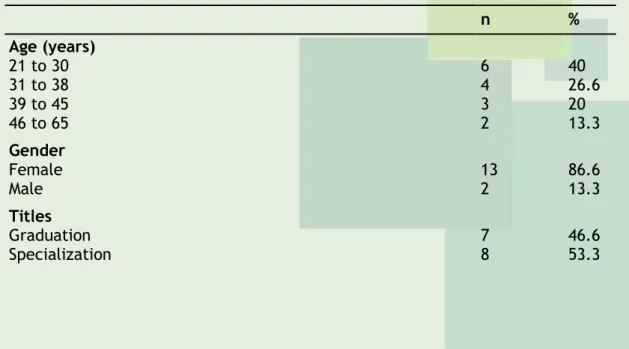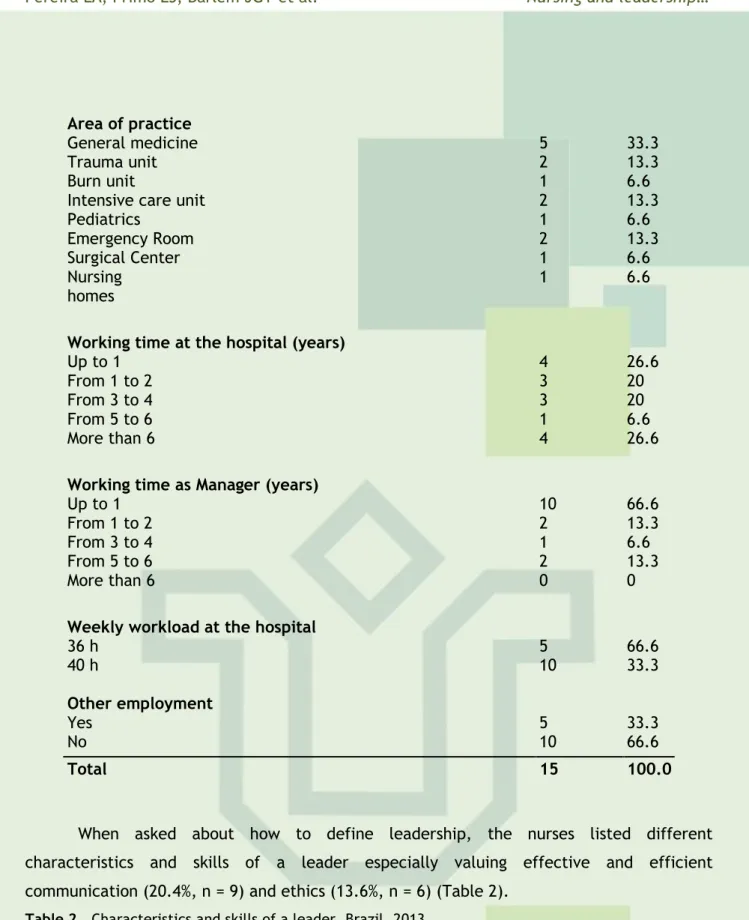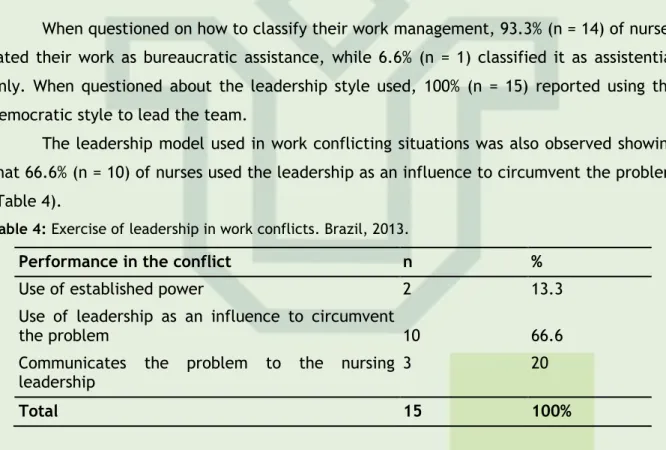J. res.: fundam. care. online 2015. jan./mar. 7(1):1875-1882
1875
RESEARCH
Enfermagem e liderança: percepções de enfermeiros gestores de um hospital do sul do Brasil
Nursing and leadership: perceptions of nurse managers from a hospital in southern Brazil Enfermería y liderazgo: percepciones de los enfermeros gestores en un hospital en el sur de Brasil
Liliane Alves Pereira 1 , Luciene Smithd Primo 2 , Jamila Geri Tomaschewski-Barlem 3 , Edison Luiz
Devos Barlem 4 , Aline Marcelino Ramos 5 , Carolina Domingues Hirsh 6
Objective: To identify how nurse managers define and exercise leadership in a philanthropic Hospital in
Southern Brazil; to identify ways of preparing these nurses for leadership. Method: this was a quantitative study, conducted with 15 nurses who worked in management positions at that hospital in 2011. A structured questionnaire applied in the field of research was used for data collection. Results: the concept of leadership is recognized positively by the nurses and is associated with effective and efficient communication and ethics, however, for such training was reduced and limited only to the undergraduate period. The resistance in the team was identified as the main barrier to the exercise of leadership.
Conclusion: Specific training is necessary with regard to leadership in nursing, qualifying professionals to a
more competent, humanized, and ethical performance. Descriptors: Leadership, Management, Nursing.
Objetivo: Identificar como enfermeiros gestores definem e exercem a liderança em um Hospital
filantrópico do Sul do Brasil; e identificar as formas de preparação destes para a atuação de liderança.
Método: estudo quantitativo, realizado com 15 enfermeiros que trabalhavam nos cargos de gestão do
referido hospital no ano de 2011. Para coleta de dados, utilizou-se um questionário estruturado aplicado no campo da pesquisa. Resultados: verificou-se que o conceito de liderança é reconhecido positivamente pelos enfermeiros e está associado à comunicação eficaz e eficiente e à ética, entretanto, a formação, para tal, foi reduzida e limitada apenas ao período da graduação. Identificou-se, ainda, que a resistência da equipe constitui-se como principal barreira para o exercício da liderança. Conclusão: se faz necessária uma formação específica no tocante à liderança para enfermagem, qualificando os profissionais para uma atuação mais competente, humanizada e ética. Descritores: Liderança, Gestão, Enfermagem.
Objetivo: Identificar cómo los enfermeros gestores definen y ejercen el liderazgo en un hospital de
caridad en el sur de Brasil, identificar maneras de preparar estos enfermeros al papel de liderazgo.
Método: Estudio cuantitativo con 15 enfermeros que trabajaban en la gestión de ese hospital en 2011.
Para la recolección de datos se utilizó un cuestionario estructurado aplicado en el campo de la investigación. Resultados: Se encontró que el concepto de liderazgo es reconocido positivamente por los enfermeros y se asocia con la comunicación y la ética eficaz y eficiente, sin embargo, para este tipo de formación se reducen y limitan únicamente al período de la graduación. También se encontró que la fuerza del equipo es la principal barrera para el ejercicio del liderazgo. Conclusión: Es necesaria una formación específica en lo que respecta a la dirección de enfermería, llamando a los profesionales para un desempeño más competente, humana y ética.Descriptores: Liderazgo, Gestión, Enfermería.
1RN. Master degree student at the Nursing Graduate Program at the Federal University of Rio Grande – PPGEnf/FURG. Email: irliliane7@hotmail.com. 2RN. Master degree in Health and Behavior. Professor at the Catholic University of Pelotas. Email: smithsprimo@yahoo.com.br. 3RN. Ph.D. i Nursing. Professor at PPGEnf/FURG. Email: jamilabarlem@furg.br. 4RN. Ph.D. in Nursing. Professor at PPGEnf/FURG. Email: ebarlem@gmail.com. 5RN. Master degree student at PPGEnf/FURG. Email: aline-ramos-@hotmail.com. 6RN. Master degree student at PPGEnf/FURG. Email: hirsch.carolina@gmail.com.
ABSTRACT
RESUMEN RESUMO
J. res.: fundam. care. online 2015. jan./mar. 7(1):1875-1882
1876
N
ursing leadership is directly related to the administration model because its concept is born in this science and solidifies with the various theories of administration that changed and evolved over the years. However, the term leadership was renowned most recently, having its beginnings in the twentieth century. These suffered terminology and concepts modifications over the years demonstrate that the administrative theories suffersocial, technological, and cultural transformations.1Given this scenario of developments affecting contemporary society, and also hospital organizations and nursing services, the confrontation of political, social, and economic instability and technological revolution is verified, that especially in Brazil put hospitals in crisis with serious consequences for the quality of services provided.2 Such situations require that hospitals seek qualified individuals to manage services and provide a humanized, competent, and ethical assistance to patients within the rules governing the exercise of professions.3
Nursing as a profession at the heart of the health system in all contexts in which it operates, comprises a set of proper components of scientific and technical knowledge reproduced by a set of social, ethical, and political practices in providing a service to human beings, in their context and circumstance of life. Therefore, the improvement in ethical professional behavior passes through the process of building an individual and collective consciousness, through the social and professional commitment, configured by the responsibility of the planning of working relationships with reflections in the technical, scientific, and political field.4
The need for nurses to integrate administrative functions to the performance of leading roles, inherent in managerial positions, is linked to the development of the work process of caring in nursing.5 In this process, the importance of leadership is realized, which today has become a challenge and a need at the same time. Leading requires values such as competence, mutual growth, commitment, honesty, and self-discipline, which causes the term leadership to not be confused with authority, power, and authoritarian postures.6
The definition of the word leadership may present itself as a major challenge because it brings a subjective character at the same time difficult to understand, and can be defined as the process to establish ways of thinking and empowering others, developing their complete capacity, and modifying the beliefs that have limited them.1 Thus, leadership demonstrates itself not only as a science or discipline, but an art, and as such, must be felt, experienced, created, and re-created.1-8
With this panorama, this study is justified by the need to identify the characteristics that delimit the profile of management and leadership in nursing, recognizing the elements present in the formation that prepare professionals to act as managers and leaders. Thus, this study had as objectives: to identify how nurse managers define and exercise leadership
J. res.: fundam. care. online 2015. jan./mar. 7(1):1875-1882
1877
RESULTS E DISCUSSION
METHOD
in a philanthropic Hospital in Southern Brazil; to identify the ways of preparing these nurses for acting in leadership positions.
This was a quantitative study, developed in a teaching hospital with a philanthropic character in Southern Brazil, with priority assistance through the Unified Health System (SUS).
A total of 15 nurses who worked in management positions at the hospital and fit the inclusion criteria participated in this study: workload of 36 or 40 hours per week, function as manager and coordinator of services in nursing teams, accept to participate in the study.
A questionnaire with close-ended questions was applied for data collection in December of 2011 investigating the specific knowledge and training that each nurse had about leadership. In the end, an open question was inserted to broaden the focus of the discussion on management and leadership. The quantitative data were analyzed using elements of descriptive statistics. The study was approved by the local Ethics Committee under Protocol 011/2010.
The sample showed a prevalence of young people, aged between 21 and 30 years, females, who had attended specialization courses, with little professional performance time in nursing, i.e. 40% of the subjects had been in the function for one year or less (Table 1).
Table 1 . Distribution of nurses according to sociodemographic characteristics. Brazil, 2013.
n % Age (years) 21 to 30 31 to 38 39 to 45 46 to 65 6 4 3 2 40 26.6 20 13.3 Gender Female Male 132 86.613.3 Titles Graduation Specialization 78 46.653.3
J. res.: fundam. care. online 2015. jan./mar. 7(1):1875-1882
1878
Area of practice
General medicine Trauma unit Burn unit
Intensive care unit Pediatrics Emergency Room Surgical Center Nursing homes 5 2 1 2 1 2 1 1 33.3 13.3 6.6 13.3 6.6 13.3 6.6 6.6
Working time at the hospital (years)
Up to 1 From 1 to 2 From 3 to 4 From 5 to 6 More than 6 4 3 3 1 4 26.6 20 20 6.6 26.6
Working time as Manager (years)
Up to 1 From 1 to 2 From 3 to 4 From 5 to 6 More than 6 10 2 1 2 0 66.6 13.3 6.6 13.3 0
Weekly workload at the hospital
36 h 40 h Other employment Yes No 5 10 5 10 66.6 33.3 33.3 66.6 Total 15 100.0
When asked about how to define leadership, the nurses listed different characteristics and skills of a leader especially valuing effective and efficient communication (20.4%, n = 9) and ethics (13.6%, n = 6) (Table 2).
Table 2 . Characteristics and skills of a leader. Brazil, 2013.
Characteristics and skills n %
Effective and efficient communication 9 20.4
Ethics 6 13.6
Search for new skills 4 9.1
Responsibility 3 6.8 Justice 3 6.8 Humility 3 6.8 Creativity 2 4.5 Impartiality 2 4.5 Patience 2 4.5
Have a passion for what they do 2 4.5
Confidence 2 4.5
Discipline 2 4.5
Persuasion 1 2.2
J. res.: fundam. care. online 2015. jan./mar. 7(1):1875-1882
1879
Dynamism 1 2.2
Tolerance 1 2.2
Total 44 100%
In addition to the characteristics and abilities of a leader listed in table 2 defining the term leadership the nurses described the main obstacles in performing leadership, indicating resistance in the team as the main barrier (80%, n = 12) (Table 3).
Table 3 . Obstacles to the performance of leadership. Brazil, 2013.
Obstacles n %
Team resistance 12 80
Lack of time to train the team 1 6.6
Centralized power 1 6.6
Inappropriate material 1 6.6
Total 15 100%
When questioned on how to classify their work management, 93.3% (n = 14) of nurses rated their work as bureaucratic assistance, while 6.6% (n = 1) classified it as assistential only. When questioned about the leadership style used, 100% (n = 15) reported using the democratic style to lead the team.
The leadership model used in work conflicting situations was also observed showing that 66.6% (n = 10) of nurses used the leadership as an influence to circumvent the problem (Table 4).
Table 4: Exercise of leadership in work conflicts. Brazil, 2013.
Performance in the conflict n %
Use of established power 2 13.3
Use of leadership as an influence to circumvent
the problem 10 66.6
Communicates the problem to the nursing leadership
3 20
Total 15 100%
When asked about the forms of preparation to engage in leadership activities, 73.3% (n = 11) of nurses claimed that the training was reduced and limited to the undergraduate period. When participation in a course, seminar, conference, lecture, or Workshop on the theme was considered, 73.3% (n = 11) of nurses stated that they had not participated in any course or event, while 26.6% (n = 4) of nurses had received some preparation for leadership during their professional training through the participation in courses and events.
In the studied hospital, the term manager is defined very narrowly as the professional who works in the Chief position eight hours a day and has the mission to lead the nursing team and direct the work in a specific unit. The understanding about leadership and the limits of professional performance as a leader are fundamental to the ethical and
J. res.: fundam. care. online 2015. jan./mar. 7(1):1875-1882
1880
competent performance, expanding the senses with regard to characteristics and qualitiesof a professional leader.2
The professionals who acted as managers in the studied institution were characterized as young professionals, who work for less than one year at the institution, and less than one year as managers, which reveals the activity of professionals who are still building themselves within the institution. All of these factors can cause some difficulty for team interaction because these professionals are still undergoing a process of construction of professional identity.3
It is obvious that not always longer working time can build the profile of a leader; however, in nursing relationships, the nursing team leader serves as an inspiration for the other members who tend to follow his example. Through his professional peculiar conduct, which has the caring activity as the essence of his formation, he is asked to mediate relations and spread the valorization of care within the health care team, knowing to listen, being available, and demonstrating responsibility and good communication.2
Accordingly, when addressing the issue of leadership, it is observed that the nurses define the term clearly and objectively indicating the effective and efficient communication and ethics as the main characteristics and skills of a leader. Thus, it is needed that nurses refine these characteristics and abilities in their work environment making them part of daily life because leadership has become a challenge and a need at the same time.
Hospital environments have increasingly assumed business outlines requiring professionals with leadership and managerial profiles.9 When leadership is discussed in association with characteristics and personal skills that a leader must have in the work environment, communication stands out as the primordial element in leadership because an effective communication will create a work environment with its own identity.2
Thus, leading requires values such as competence, mutual growth, commitment, honesty, and self-discipline, which causes the term leadership to not be confused with authority that legitimates authoritarian postures.6.10
Although the term leadership is directly linked to interpersonal relationships and its definitions are guided in community actions, the greatest difficulty in the exercise of leadership is the resistance of the team to its applicability. However, one cannot assert that this occurs only as a function of teams being little receptive or because the leadership is not correctly exercised. The exercise of leadership requires collaboration and awareness, so that the exercise can be expanded to the extent that leadership is understood as a way to influence people to achieve a common goal.8
It is important to note that the professional training for leadership as those acquired through courses, lectures, and seminars is scarce, since most of the interviewed nurses had not participated in any form of improvement and were limited to training received in undergraduate courses for the exercise of leadership. However, leadership is an indispensable tool in activities carried out by the nurse because the professional must perform functions and competencies that incorporate different skills and abilities, which requires a more in-depth study on concepts, theories, and research on leadership from these professionals.11
J. res.: fundam. care. online 2015. jan./mar. 7(1):1875-1882
1881
To talk about leadership in nursing with a focus in management is extremelychallenging yet necessary to create a culture of leadership among professionals, so important and essential to the bureaucratic-assistential model in which the professional nurse transits.
It is noted that, even leadership being a current requirement, its training is far short of what is needed. Thereby, it is necessary to create strategies that are capable of awakening the nurse manager to search for knowledge in the area of leadership as well as expand the specific training to the management area.
J. res.: fundam. care. online 2015. jan./mar. 7(1):1875-1882
1882
REFERENCES
1. Marquis LB, Huston CJ. Administração e liderança em enfermagem. 2ªed. Ed. Artmed. Porto Alegre: 1999.
2. Trevizam MA, HIGA, E.F.R. Os estilos de liderança idealizados pelos enfermeiros. Rev Latino-am Enferm; 2005;13(1):59-64.
3. Sousa LB, Barroso MGT. Reflexão sobre o cuidado como essência da liderança. Esc Anna Nery Rev Enferm; 2009;13(1):181-7.
4. Conselho Federal de Enfermagem. Código de ética dos profissionais de enfermagem. COFEN, 2007.
5. Santos I, Castro BC. Características pessoais e profissionais de enfermeiros com funções administrativas atuando no Hospital Universitário. Rev Esc Enferm USP;2010;44(1):154-60. 6. Lourenço MR, Trevisan MA. Líderes da enfermagem brasileira: sua visão sobre a temática da liderança e sua percepção a respeito da relação liderança & enfermagem. Rev Latino-Am Enferm;2001;9(3):14-9.
7. Join Comission Resourses. Temas e estrategias para liderança em enfermagem. Enfrentando os desafios hospitalares atuais. Ed. Artmed. Porto Alegre: 2008.
8. Basanelli AP, Cunha ICKO. Liderança no contexto da enfermagem. Rev Esc Enferm USP;2006;40(1):117-22.
9. Vendemiatti M, Siqueira ES, Filardi F, Binotto E, et al. Conflito na gestão hospitalar: o papel da liderança. Ciênc & Saúde Col;2010;15(1):1301-14.
10. Rorty R. Contingency, irony and solidarity. Cambridge, New York: Cambridge University Press, 1995.
11. Mendes IAC, Trevizan MA, Ferraz CA, Hayashida M. Liderança da enfermeira na perspectiva da ética pós-moderna. Rev Bras Enferm; 2000; 53(3)410-4.
Received on: 28/02/2014 Required for review: No Approved on: 29/10/2014 Published on: 01/01/2015
Contact of the corresponding author: Liliane Alves Pereira Campus Carreiros: Av. Itália km 8 Bairro Carreiros


